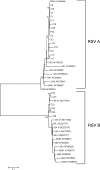Molecular characterization of a respiratory syncytial virus outbreak in a hematology unit in Heidelberg, Germany
- PMID: 23100345
- PMCID: PMC3536189
- DOI: 10.1128/JCM.02151-12
Molecular characterization of a respiratory syncytial virus outbreak in a hematology unit in Heidelberg, Germany
Abstract
In 2011 and 2012, a large outbreak of respiratory syncytial virus (RSV) infections affecting 57 laboratory-confirmed patients occurred in an adult hematology unit in Heidelberg, Germany. During the outbreak investigation, we performed molecular genotyping of RSV strains to differentiate between single versus multiple introductions of the virus into the unit. Furthermore, we assessed the time of viral shedding of consecutive samples from the patients in order to better understand the possible impact of prolonged shedding for outbreak control management. We used subtype-specific reverse transcription-PCR on nasopharyngeal and bronchoalveolar specimens for routine diagnostics and for measuring the viral shedding period. Samples of 47 RSV-infected patients involved in the outbreak were genotyped by sequence analysis and compared to samples from RSV-infected hospitalized children representing the timing of the annual RSV epidemic in the community. Molecular investigation of the virus strains from clinical samples revealed a unique cluster with identical nucleotide sequences of RSV type A (RSV A outbreak strain) for 41 patients, while 3 patients were infected with different RSV A (nonoutbreak) strains and three other patients with RSV type B. Outbreak strains were identified in samples from November 2011 until January 2012, while nonoutbreak strains were from samples coinciding with the community epidemic in February and March 2012. Median duration of viral shedding time was 24.5 days (range, 1 to 168 days) with no difference between outbreak and nonoutbreak strains (P = 0.45). Our investigation suggests a single introduction of the RSV A outbreak strain into the unit that spread among the immunocompromised patients. Prolonged viral shedding may have contributed to nosocomial transmission and should be taken into account in the infection control management of RSV outbreaks in settings with heavily immunosuppressed patients.
Figures




References
-
- Hall CB. 2001. Respiratory syncytial virus and parainfluenza virus. N. Engl. J. Med. 344: 1917– 1928 - PubMed
-
- Hall CB, Douglas RG., Jr 1981. Modes of transmission of respiratory syncytial virus. J. Pediatr. 99: 100– 103 - PubMed
-
- Garcia O, Martin M, Dopazo J, Arbiza J, Frabasile S, Russi J, Hortal M, Perez-Brena P, Martinez I, Garcia-Barreno B. 1994. Evolutionary pattern of human respiratory syncytial virus (subgroup A): cocirculating lineages and correlation of genetic and antigenic changes in the G glycoprotein. J. Virol. 68: 5448– 5459 - PMC - PubMed
-
- Sullender WM, Mufson MA, Prince GA, Anderson LJ, Wertz GW. 1998. Antigenic and genetic diversity among the attachment proteins of group A respiratory syncytial viruses that have caused repeat infections in children. J. Infect. Dis. 178: 925– 932 - PubMed
-
- Hall CB, Walsh EE, Long CE, Schnabel KC. 1991. Immunity to and frequency of reinfection with respiratory syncytial virus. J. Infect. Dis. 163: 693– 698 - PubMed
Publication types
MeSH terms
Substances
Associated data
- Actions
- Actions
- Actions
- Actions
- Actions
- Actions
- Actions
- Actions
- Actions
- Actions
- Actions
- Actions
- Actions
- Actions
LinkOut - more resources
Full Text Sources
Medical

